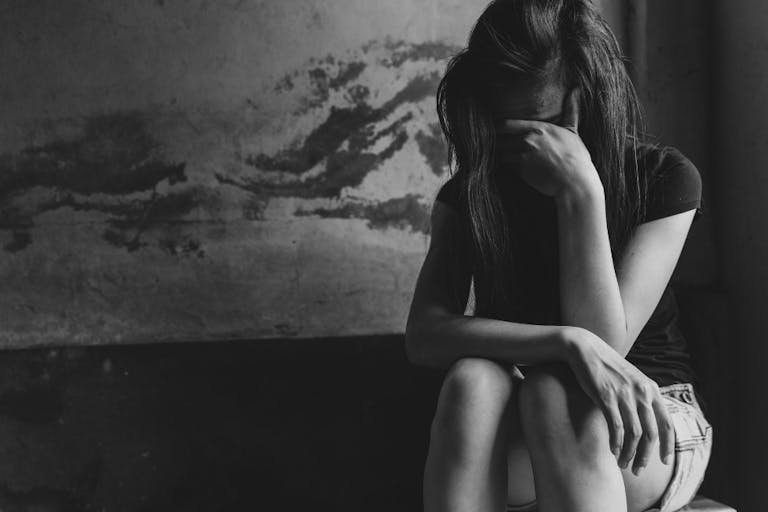
Sex trafficking, the FBI, and the Biden administration’s counterintuitive promotion of abortion
Cassy Cooke
·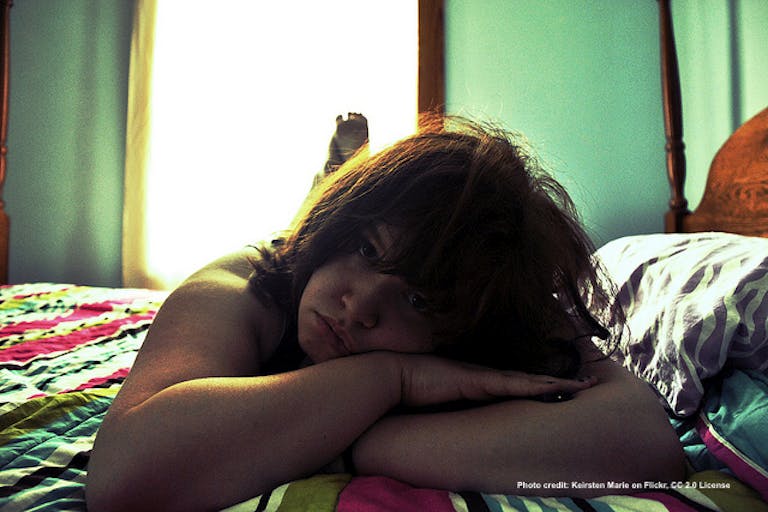
Investigative·By Carole Novielli
Why is Planned Parenthood ignoring these red flags of sexual abuse?
Live Action has just released stunning evidence in its Aiding Abusers docuseries, showing how Planned Parenthood has systematically and repeatedly aided abusers. There is a horrific, growing list of criminal cases against adult sexual predators who preyed on children as young as 12 years of age, taking them to Planned Parenthood for abortions to cover their crimes. Undercover investigations and testimony from former Planned Parenthood staffers proves that the taxpayer-funded organization is fast becoming the nation’s largest complicity machine in the cover-up of child sexual abuse.

Adolescents and teen girls are being sexually abused and taken to Planned Parenthood for a variety of reasons, including abortions. And, as Live Action’s investigative report and docuseries, along with Live Action News articles demonstrate, Planned Parenthood continues to turn a blind eye to victims of sexual abuse and rape, often returning them back to the arms of their abusers. Despite the data — which shows that younger sexually active girls are likely involved with partners three to six years older — Planned Parenthood views these girls as sexually promiscuous and in need of its “services” instead of suspecting abuse.
According to data researched by Mike Males, senior researcher at the Center on Juvenile and Criminal Justice, San Francisco, and published in Yes Magazine in 2016:
[T]he Centers for Disease Control and Prevention reported that two-thirds of all marital births and 44 percent of unwed births among mothers age 18 and younger were fathered by adult men 20 years of age and older. Some 10,000 of those cases involved men older than 24. And these are just births; total sexual encounters would be many times higher…
Research published in 2006 on the website of Planned Parenthood’s own former special affiliate, the Guttmacher Institute, states, “… [A]mong sexually experienced teenagers, the youngest are the most likely to report having had an older first sexual partner.”
In 2013, Planned Parenthood claimed in a report that 6.7% of teens between the ages of 15 and 17 “have partners six or more years older than they are.” That means that nearly seven percent of girls who are just 15 years old, could be having sex (willingly or unwillingly) with an adult male who is 21 or older. Census estimates show that there were roughly 6.3 million females between 15 and 17 in the US in 2016. Within that age group, less than half are reported to be sexually active. Knowing this, and if Planned Parenthood’s claim is correct, that would indicate that there are potentially 210,000 15- to 17-year-old girls who may be at risk for statutory rape. Some states set the age of consent at 16 years old, while some set it at 17 or 18.
Planned Parenthood’s own glossary of terms describes statutory rape as “[l]egally, sexual contact between an adult and anyone who is below the age of consent, whether or not the contact is voluntary.”
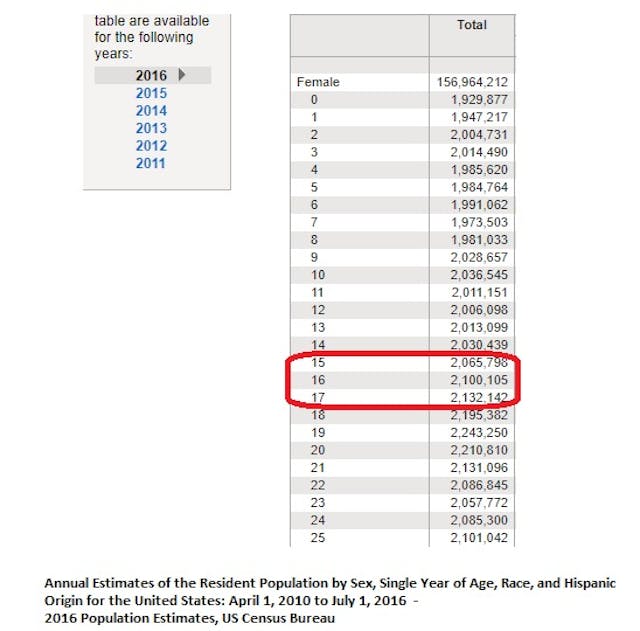
But the problem is even more magnified when the victim is not “consenting” or is much younger. Studies show that younger girls are less likely to engage in sex, yet when a sexually active adolescent or teen girl presents at Planned Parenthood, she fails to invoke suspicion of abuse. Why?
According to research published on Guttmacher’s website, “On average, young people in the United States have sex for the first time at about age 17… ” Of those who are sexually active at a young age, additional data shows that young girls with a much older “romantic partner” are more likely to engage in sex.
Yet, Planned Parenthood continues to miss all these red flags.

A study published by the Journal of Women’s Health in 2011 found that “[i]n national surveys, nearly 50% of sexually active adolescent females reported having a sex partner ≥2 years older, and 36% reported a partner ≥3 years older.” Participant demographic from the study “were, on average, 14.6 years old at first vaginal intercourse. Their first vaginal intercourse partners were, on average, 17.5 years old. Sixty percent of the sample had a first sex partner who was ≥2 years older, and 41% of the sample had a first sex partner who was ≥3 years older.”
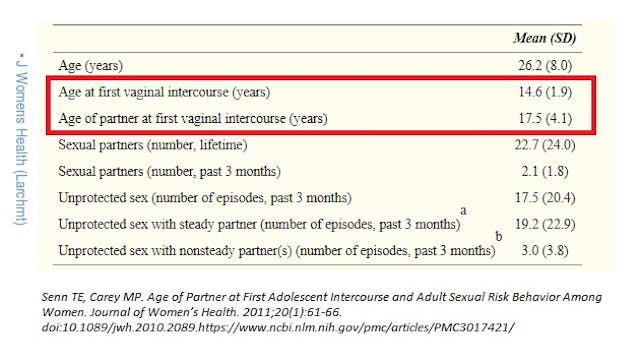
The report goes on to state that “[f]or adolescent females, having sex with an older male partner correlates with a variety of negative health outcomes… adolescent females who had a sex partner who was ≥6 years older had a pregnancy rate almost four times that of adolescent females with a similar-aged sex partner.”
A report from 2014 found that “[n]early 36 percent of girls who first got pregnant before age 15 had sex for the first time with a partner at least six years older, compared to 17 percent of girls who got pregnant between 15 and 19.”
In Planned Parenthood’s previously mentioned 2013 report, the abortion corporation states:
Article continues below
Dear Reader,
In 2026, Live Action is heading straight where the battle is fiercest: college campuses.
We have a bold initiative to establish 100 Live Action campus chapters within the next year, and your partnership will make it a success!
Your support today will help train and equip young leaders, bring Live Action’s educational content into academic environments, host on-campus events and debates, and empower students to challenge the pro-abortion status quo with truth and compassion.
Invest in pro-life grassroots outreach and cultural formation with your DOUBLED year-end gift!
Forty-six percent of teenage girls and 22 percent of teenage boys who engage in their first sexual experience before the age of 15 have been involved in a pregnancy.
A 2002 review of 1,975 female participants from the National Longitudinal Study of Adolescent Health found that substantial age gaps play a large role in whether a young girl will engage in sex:
Adolescent females involved with an older partner have higher odds of having intercourse with that partner than females with partners their own age, after adjustment for demographic covariates. The magnitude of this association is most dramatic among the youngest females—for example, the odds of intercourse among 13-year-old females with a partner six years older are more than six times the odds among 13-year-old females with a same-age partner (odds ratio, 6.4), while 17-year-old females with partners six years older have about twice the odds of intercourse when compared with those who have a same-age partner (2.1).
The report also noted that “[f]emales aged 13 or younger with a partner at least four years their senior were more likely to have had sex than were those with a partner of the same age or younger (41% vs. 9%)… It thus seems that while sexual intercourse is less common for females who are 13 or younger at the onset of their relationships, substantial age gaps between partners may play a larger role in the progression to intercourse in this age-group than in others.”
In other words, if a child at this young age is showing signs of sexual activity, it is likely they are engaging in a sexual relationship with an older partner. Therefore, when a young girl at the age of 12, 13, or 14 shows up at Planned Parenthood pregnant or in need of birth control or seeking an abortion, it should automatically trigger a suspicion of abuse. Yet, this red flag is being deliberately overlooked by Planned Parenthood.
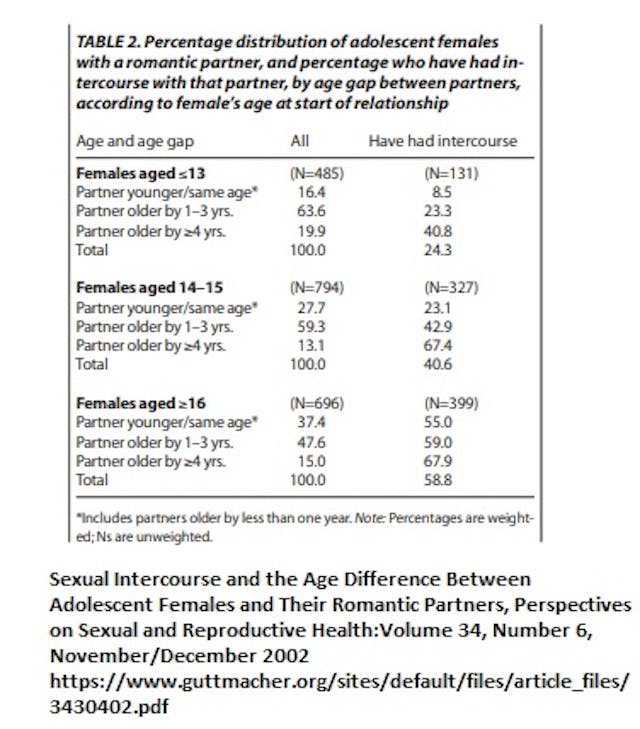
Demographic information of participants in the report, shown in Table 2, indicate that of participants who were younger than 13:
23.3% had a sexual partner that was one to three years older.
40.8% had a sexual relationship [most likely with men] who were four years or more older.
In addition, out of participants who were between the ages of 14 and 15:
42.9% engaged in sex with partners that were one to three years older.
67.4% had sex with men who were four years older or more.
A 2008 study found that young females who admitted to authors that they had an older sexual partner were more likely to also claim that the sexual encounter was non-consensual. The report, entitled, “Older Sexual Partners During Adolescence,” found that “[y]oung females with older sexual partners are less likely than other sexually experienced teenage women to report that the relationship is ‘steady,’ and are more likely to report that their first sexual intercourse was nonvoluntary or unwanted.”
In addition, a 2015 review of available data, published by the non-profit group Child Trends, found that younger teens are more likely to report first sexual experiences as “statutory rape”:
Among those whose first sexual experience was before age 16, the youngest sexually experienced teens were most likely to report their sexual experience as “statutory rape.” Overall, in 2011-13, 17 percent of males and 33 percent of females who had sexual intercourse before age 16 reported that their first time was with someone who was at least three years older than them. Males who were 15 at first sex were less likely than males ages 14 or 13 or younger at first sex to have reported this experience as “statutory rape” (7 percent, compared with 22, and 24 percent, respectively). Females who were 15 at first sex were also less likely to have experienced “statutory rape” than females ages 14 or 13 or younger at first sex (21 percent, compared with 45, and 48 percent, respectively).
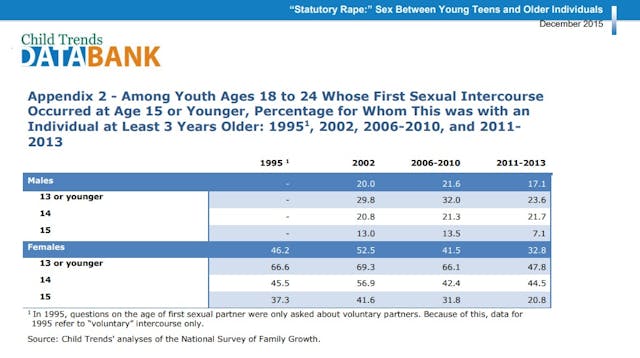
In the table from the report shown below, 47.8% of 13-year-old-, 44.5% of 14-year-old-, and 20.8% of 15-year-old female adolescents from the data Child Trends reviewed had a first sexual relationship with someone three years or older. The report does not indicate whether the partners were adults, necessarily, but it does show a pattern that is troubling and should cause concern when sexually active teens present to a medical facility or clinic.
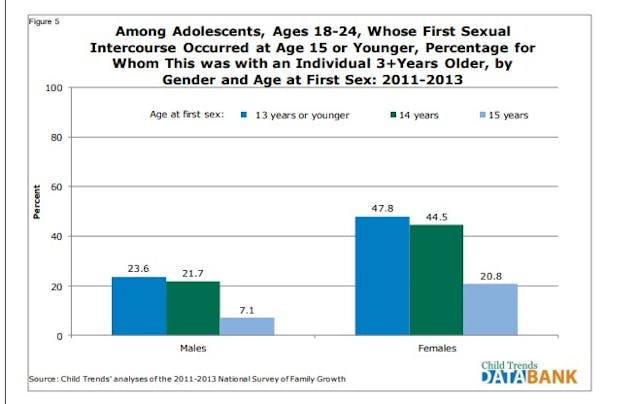
A report published in June 2017 by Perspectives on Sexual and Reproductive Health, which looked at partner age gaps among females and males who first had intercourse before age 18, found that out of those who first had sex before age 15:
19% had a partner who was 5+ years older than them and
30% had a partner who was 3-4 years older.
What this reveals is that very early sexual experiences are more likely to happen with an older partner.
This information was found in Table 2, from the report entitled, “Associations of Partner Age Gap at Sexual Debut with Teenage Parenthood and Lifetime Number of Partners.“ The table of data also revealed that even though the percentages of older partners was reported as lower among females in the study who first had sex at ages 15-17, they are still alarming and demonstrate that the possibility of substantial incidents of statutory rape may be occurring:
11% had a partner who was 5+ years older than them and
13% had a partner who was 3-4 years older.
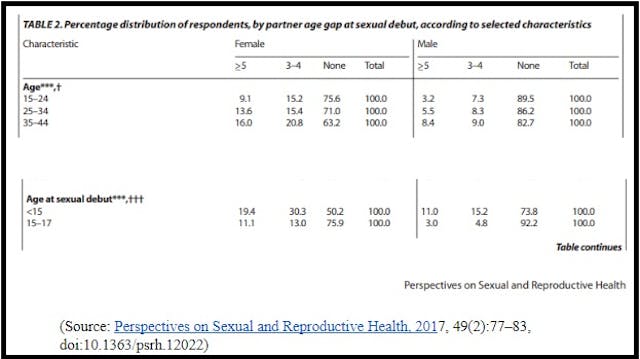
As Live Action’s “Aiding Abusers” series has documented, when a young girl is taken to Planned Parenthood, the abortion corporation’s solution is not to view them as potential victims of sexual abuse but to hook them on contraceptives or sell them abortions, which fuel Planned Parenthood’s bottom line. This negligent attitude traps these victims of sexual abuse and grants aid to the abusers, by giving them a way to avoid getting caught.
Live Action founder and president Lila Rose stated in a press release:
Despite Planned Parenthood’s public rhetoric as well as laws requiring it to report suspected abuse, its failure to report has been deliberate and widespread. Time and again, rather than reporting abuse to authorities, Planned Parenthood has repeatedly looked the other way and performed abortions on victims as young as 12 years old. These girls deserved advocacy but instead Planned Parenthood staff ignored their abuse and returned them to the waiting arms of their abusers.
Because of flagrant violations like these, the proposed Title X rule tightening on reporting abuse is absolutely necessary. Planned Parenthood has proven that its priority is selling abortions, not caring for the most vulnerable of girls. Planned Parenthood’s culture of cover-up must end, the cycle of abuse of innocent children must end, and Planned Parenthood’s half a billion dollars in annual federal funding must end. Taxpayers cannot be forced to subsidize these abuses of children.
In the #MeToo and #TimesUp era of intolerance against sexual abusers and those who are complicit in aiding the abuse, it is past time to open up investigations in every state to see just how prevalent the failure to report sexual abuse is within the largest taxpayer-funded abortion chain in the United States. Anything short of a full-on investigation and removal of tax funds through federal programs like Title X and Medicaid would be to diminish the agonizing suffering endured by victims of sexual abuse routinely ignored by Planned Parenthood, often in violation of state and federal law.
Live Action News is pro-life news and commentary from a pro-life perspective.
Contact editor@liveaction.org for questions, corrections, or if you are seeking permission to reprint any Live Action News content.
Guest Articles: To submit a guest article to Live Action News, email editor@liveaction.org with an attached Word document of 800-1000 words. Please also attach any photos relevant to your submission if applicable. If your submission is accepted for publication, you will be notified within three weeks. Guest articles are not compensated (see our Open License Agreement). Thank you for your interest in Live Action News!

Cassy Cooke
·
Abortion Pill
Carole Novielli
·
Investigative
Carole Novielli
·
Investigative
Carole Novielli
·
Investigative
Nancy Flanders
·
Investigative
Nancy Flanders
·
Abortion Pill
Carole Novielli
·
Abortion Pill
Carole Novielli
·
Investigative
Carole Novielli
·
Abortion Pill
Carole Novielli
·
Investigative
Carole Novielli
·